|
Later Years
John Harris died in February 1925 from the after effects
of a massive stroke, which he had suffered 7 years
earlier. The last years of his life were spent at home
in bed. He died at the age of 69. He had been a very
religious man, and even preached in the house, which is
probably from where his daughter Fanny obtained her beliefs
that led to her joining the Salvation Army.
Harry Lunn's brother George was
very musically and mechanically minded. His mechanical
enthusiasm started at an early age playing with Meccano.
He made musical instruments including a violin, which he
played extremely well, especially considering that he
was self-taught. He also got interested in electricity
and early radios. The Whitehouse family were given an
old film projector and George Lunn modified it by
fitting a battery powered lamp. The projector, which
worked reasonably well was used in the cellar. |
|
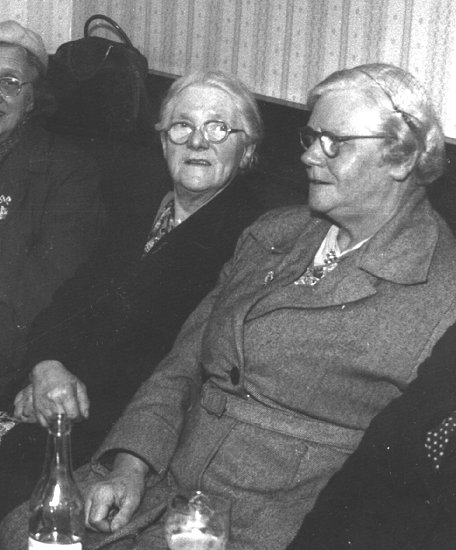
Sarah Flavell and her sister Mary
during an evening at the New Junction. |
May Flavell bought a wind-up gramophone, and played
her favourite record "The Laughing Policeman" again and
again. She started going out with Enoch Firm whose late
brother Fred had been married to Laura Davies.
Her father Henry didn't like the girls staying out
late, and so Daisy used to help May by keeping a lookout
for her, and quietly opening the door so that she could
sneak-in without being heard.
If the children were naughty and sent to bed hungry,
she would sneak food into the bedroom for them, and tell
stories.
Jack had no money for clothes and so used to borrow
some of Henry's when he wasn't looking. This went on for
sometime until Henry found out, after which they had a
big row. |
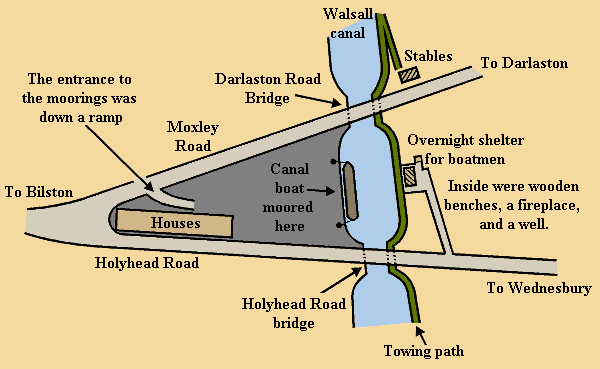
The location of the mooring at Moxley that was
used by Henry.
| Henry enjoyed gardening, and had one of the
allotments in Forge Road which provided the family with
all of their fruit and vegetables.
He also enjoyed a pint or two of beer and would often
borrow two shillings and sixpence (half a crown) from
Daisy to pay for it. |
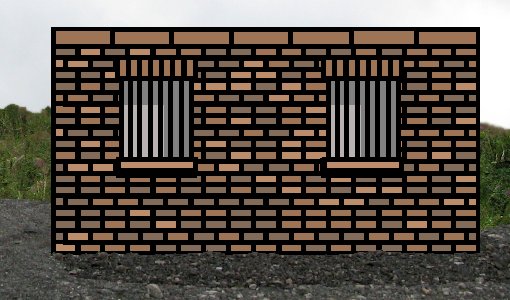
An impression of the old stables
in Moxley Road. |
|

The overnight shelter by the canal
at Moxley. |
Henry's business was going strong.
He transported all kinds of goods on the canal including
coal, stone, and even acid carbides from Wednesbury
Chemical Works. He often travelled through the Dudley
canal tunnel using poles to push the boat along. For
just a few pence someone would collect the horse at the
tunnel entrance and take it to the other end ready to
rejoin the boat.
He was often away for days at a
time on long journeys and so used to cook his meals on a
shovel, over the fire in the boat. He moored the boat at
Moxley, and kept the horse in the local stables. The
horses were well looked after as the man who ran the
stables even slept with them.
Opposite the moorings was a shelter
where canal boatmen could spent the night. It had stone
walls, and contained wooden benches on which they sat
and slept, a small fireplace, and a well, just in front
of the window. The remains of the building can still be
seen today, although it is partly buried by the large
bank of earth that carries the Black Country Route
through Moxley.
The boating business had its ups
and downs, and so Henry sometimes had to find temporary
work elsewhere. In the mid 1920's he worked for a time
at a quarry in Bradley Lane, breaking stone. The quarry
became known as “The Cracker” because of the blasts from
the explosions which removed the rock. He also worked at
Wards, helping to dig clay for their terracotta pots. |
| May eventually married Enoch Firm and they went to
live in Bilston Street with Enoch's uncle but soon moved
to 11 Factory Street, almost directly behind the old
yard.
Their next door neighbour was May's Aunt Lizzie and
Uncle Sam, who had three children, Tom, George, and
Elizabeth (who died at the age of 2). |
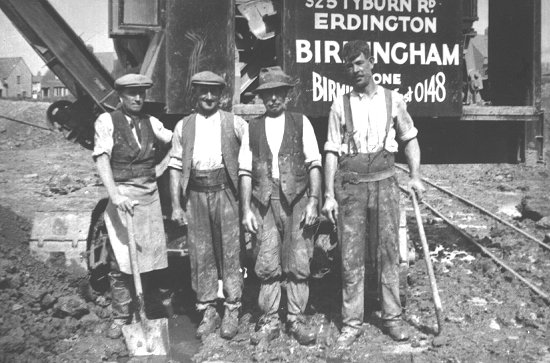
Henry (3rd from the left) digging
clay at Wards. The crane was called "The Devil". |
|
In 1927 Daisy left school, and
shortly afterwards started work at the Ward's house in
Moxley Road, looking after both the house and their two
children. The Ward family owned the clay pot works on
the site of the old Baggott's Bridge Brick Works
alongside the canal.

Workers at Ward's clay
pit in the 1930s. Henry is in the centre of
the front row, holding a bottle on his knee.
Courtesy of John & Christine Ashmore. |
During the 1920s the character of
the area changed considerably. George Rose Park appeared
in the middle of the decade on derelict mining land.
Where Wiley Avenue is today there was just a bare earth
track with trees in the hollow, and a rope walk to the
south of where Berry Avenue now stands. The area
contained spoil heaps and hollows from the old coal
mines.
This all disappeared when Darlaston
began its municipal housing scheme which was designed to
finally improve the dreadful housing conditions that
many people had to suffer. The first houses were built
in Partridge Avenue and Park Road. Slowly the whole area
to the south and west of Park Road was covered with new
housing, which removed much of the over crowding in the
district. |
|
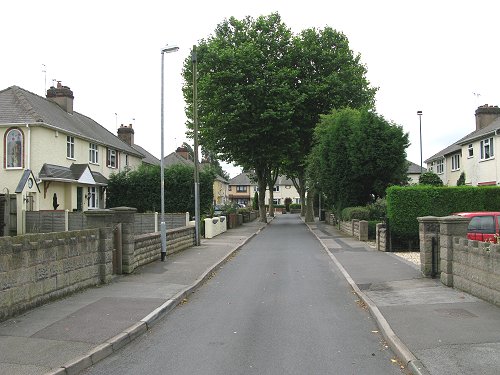
Partridge Avenue today. |
The rebuilding program resulted in many of the
inhabitants of Park Road being re-housed.
In the early 1930s the Whitehouses moved to Berry
Avenue, and were soon followed by the Flavells.
The Perrins family moved to Heathfield Lane West, as
did the Lunns.
The new houses would have seemed like a palace when
compared to the poor conditions in the old Victorian
dwellings. |
|
The old yard and the surrounding
houses survived until the mid 1960's when they were
demolished and replaced with the houses that are still
there today. The area has changed beyond recognition and
it’s now hard to imagine just what it was like only 80
years or so ago. |
 |
 |
Return to
More Children |
Return to
the contents |
|